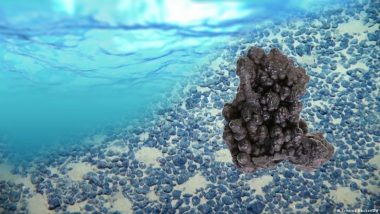Mining companies are looking to the ocean floors to extract rare earths and metals that are in huge demand but short supply. How will it work and what are the consequences?In the mid-nineteenth century, science fiction author Jules Verne wrote of precious metals lying thousands of meters underwater.
Also Read | World News | Ahead of Bilateral, Bhutan King Jigme Wangchuk Received by PM Modi.
"In the depths of the ocean, there are mines of zinc, iron, silver and gold that would be quite easy to exploit," stated Captain Nemo in Verne's classic adventure tale, "20,000 Leagues Under the Sea."
Also Read | Sports News | Retired Boxer Amir Khan Gets 2-year Ban for Doping.
The author was right about the potential raw materials. He was wrong, however, to assume that the minerals could be easily exploited.
Currently there is no internationally agreed code for mining under the ocean. After two weeks of negotiations ending March 31, the International Seabed Authority (ISA) decided that companies can apply from July to to mine the ocean floor. But campaigners and even corporations are pushing back due to fears of massive environmental impacts.
"The deep sea is a trove of biodiversity, rich in living resources used in medicines and critical in regulating the climate and providing spawning and feeding grounds for fish," said Diva Amon, a Caribbean marine biologist and an advisor to the Benioff Ocean Initiative at the University of California. "The planet would not be the same without it."
Metals too rare to power the energy transition
Whether copper or nickel for batteries, cobalt for electric cars or manganese for steel production batteries:rare earth minerals and metals are fundamental to the renewable energy technologies driving the energy transition.
But while demand is fast-rising, the resources are also becoming scarcer globally.
According to estimates, in just three years the world will need twice as much lithium and 70% more cobalt than today.
And this is despite the energy transition's slow progress. According to the International Energy Agency, if climate goals were properly pursued through the massive expansion of renewable energy, about five times as much lithium and four times as much cobalt would be needed by 2030 than today.
The projected production volumes for these raw materials fall far short of demand. To close this gap, some countries and companies now want to mine the resources in the deep sea.
Harvesting valuable manganese nodules from the seabed
So-called polymetallic nodules, also known as manganese nodules, are driving the rush to mine seabeds. These potato-sized lumps contain high proportions of nickel, copper, manganese, rare earthsand other valuable metals.
The best-studied area is currently the seabed at between 3,500 and 5,500 meters [between 2.18 and 3.42 miles] in the Clarion-Clipperton Zone in the eastern Pacific Ocean near Hawaii. Thousands of kilometers long, the area contains more nickel, manganese and cobalt than any known area on land.
The basin in the central Indian Ocean and the seabed off the Cook Islands, Kiribati Atolls and French Polynesia in the South Pacific are also of interest for potential extraction.
"The nodules' composition happens to be remarkably well-aligned with the needs of electric vehicle makers," said Gerard Barron, CEO of Canada-based The Metals Company. "Carmakers will need a great deal more of these metals in order to make battery cathodes and electrical connectors for an electric vehicle fleet of around a billion cars and trucks by mid-century."
The company specializes in the medium and long-term exploitation of mineral resources in the Clarion-Clipperton Zone.
Although manganese nodules are not yet being mined anywhere in the world, that could soon change as they practically lie directly on the seabed and can be easily extracted without breaking up rock layers or eroding the seabed.
Automated mining endangers marine life
Seabed mining is made easy when a huge vacuum can simply travel over the ocean floor to suck up the nodules — which are then brought to the surface with a hose.
But the living part of the seabed is destroyed along with the nodules, says Matthias Haeckel, a scientist at the Helmholtz Centre for Ocean Research in Kiel.
"That means all organisms, bacteria and higher organisms that live in and on the sediment and on the nodules are completely sucked in."
These organisms also require manganese nodules to survive, meaning they "won't come back for millions of years," says Sabine Gollner, senior scientist at the Royal Netherlands Institute for Sea Research.
Rapid regeneration is impossible because it takes a million years for a nodule to grow to between 10 millimeters and one centimeter.
Scientists and opponents of deep-sea mining also fear that the clouds of sediment from the suction could cause enormous damage to ecosystems within a several hundred kilometer radius.
Victims include plants, creatures in the middle water depths and micro-organisms whose respiratory tracts can be blocked by the sediments. include corals, sponges, anemones.
Striking a better environmental balance
The Metal Company wants to mine the nodules in the Clipper Zone in the future and makes no secret of the possible damage to marine biodiversity.
However, the company argues that deep-sea mining could be less damaging to the environment than extraction on land, including 80% less greenhouse gas emissions.
The company claims that deep-sea mining would barely impact carbon reservoirs such as forests and soils, would not displace people, would use less fresh water and release fewer toxins.
The Metal Company also claims that mining deep at sea would be largely automated, meaning it would be free of the exploitation of cobalt miners, including children, in the Democratic Republic of Congo, where most of the world's cobalt is mined today.
Could underwater mining begin soon?
Possible exploitation of deep-sea deposits is regulated by ISA, which was established under the UN Convention on the Law of the Sea. It has awarded 31 exploration contracts so farm but none for commercial mining activities worldwide.
These permits allow companies to explore the resources and potential for future extraction, but also require them to collect data for environmental analysis.
The Jamaica-based authority has been working on rules on whether, how and where deep-sea mining could be possible at all. At a recent two-week conference , the ISA's 167 member states continued 10 years of negotiations for a global mining code. The hope is to adopt the code by July so deep-sea mining applications can be adjudicated around robust rules that protect the environment.
The Pacific island state of Nauru has been collaborating with The Metal Company to force through a code by 2023 so applications can be decided.
But other island nations are calling for a moratorium on deep-sea mining.
"Deep-sea mining would go beyond harming the seabed and have a wider impact on fish populations, marine mammals, and the essential function of the deep-sea ecosystems in regulating the climate," Vanuatu's representative, Sylvain Kalsakau, said during the negotiations.
For marine biologist Gollner, there is still a lack of sufficient data for environmentally friendly underwater mining: "Based on the current data situation, deep-sea mining cannot be managed in a way that would not be harmful to the environment." She advocates for a moratorium based on the data, saying "now would be too early."
Some corporations including BMW, Volkswagen, Google, Philips and Samsung SDI have joined a WWF call for a moratorium and pledged not to use raw materials from the deep seabed or finance deep-sea mining for the time being.
"It's great to see how the deep ocean has inspired support from people and voices across the world," said Caribbean marine biologist, Diva Amon. "Hopefully this momentum for a pause will only keep growing."
This article was adapted from German. Stuart Braun contributed reporting.
(The above story first appeared on LatestLY on Apr 04, 2023 03:00 PM IST. For more news and updates on politics, world, sports, entertainment and lifestyle, log on to our website latestly.com).













 Quickly
Quickly



















